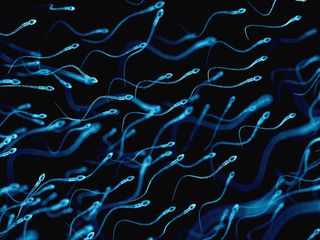Sperm Can Survive Microgravity, but Don’t Expect Any Space Babies Soon

Frozen sperm samples can remain viable after exposure to microgravity conditions that are somewhat similar to those found in space, new research reveals.
The findings, which were presented today (June 24) at the European Society of Human Reproduction and Embryology in Vienna, suggest that at least one obstacle on the path towards space-based reproduction may not be insurmountable.
However, the study doesn't actually demonstrate how sperm would fare in space, and even if they did, we are still light-years away from making space babies using frozen sperm, one expert told Live Science. [Sending Humans to Mars: 8 Steps to Red Planet Colonization]
Baby space colonists?
Sex in space would be difficult and dangerous for a lot of reasons. There are the obvious mechanical challenges (blame Newton's third law) and the tremendous threat to a developing embryo posed by cosmic radiation.
Microgravity also dramatically impairs the circulatory, respiratory and reproductive systems. As a result, scientists are looking to artificial reproduction as the primary means of populating hypothetical colonies beyond Earth, said Montserrat Boada, director of an embryology laboratory at Dexeus Mujer, a women's health center in Barcelona, Spain, and one of the researchers involved in the study.
Such research is necessary because moving conception from the spacesuit to the test tube will only solve some of the many, many problems inherent in reproduction beyond Earth's atmosphere.
For instance, scientists still have no idea how spaceflight will affect the prenatal development of any eventual baby space colonists.
Sign up for the Live Science daily newsletter now
Get the world’s most fascinating discoveries delivered straight to your inbox.
"Microgravity affects molecular and cell structure," Boada told Live Science."There are many studies published in the animal model and other tissues and cells in humans, but little is known about the effects of different gravitational environments on gametes, eggs and embryos."
To better understand how microgravity affects sperm, Boada collaborated with microgravity engineers from the Polytechnic University of Barcelona and members of an aero club for amateur flyers in Spain.
The researchers collected samples from 10 healthy volunteers and froze them, using techniques commonly employed in earthbound fertility treatments. The experimental samples were strapped into a two-seat aerobatic aircraft, or a heavier-than-air craft designed for performing hair-raising maneuvers that aren't normally performed during flight. The samples were taken for a wild ride that included about 20 parabolic maneuvers, which exposed the samples to gravitational conditions ranging from space-like microgravity to gravitational forces that were two to three times as strong as those experienced on Earth.
"We have chosen aerobatic flight because it has been proven effective" in simulating the effect of spaceflight, Boada said.
After the flights, the researchers thawed the samples and compared the sperm to control samples that had been stored on the ground. The scientists assessed sperm viability by measuring seven characteristics, including sperm motility and DNA fragmentation.
"It seems there is no alteration of frozen human sperm samples after exposure to microgravity," Boada said.
Many questions remain
While these findings are encouraging, the results from this type of pilot study are far from definitive.
"This conclusion fails to consider the realities of sperm bank requirements for use in safe human reproduction, nor the realities of the space flight conditions under chronic exposure to microgravity and space flight radiation," said Joseph Tash, an emeritus professor at the University of Kansas Medical Center.
The parabolic maneuvers used in the study caused rapid, alternating changes in gravitational force that "are not experienced in prolonged true space flight," Tash told LiveScience via email.
Tash is leading a NASA study that seeks to answer similar questions, using samples from the International Space Station. Those results will be presented at a scientific meeting in November, Tash said.
The effect of microgravity is just one of many hurdles researchers must clear before safe human reproduction beyond earth becomes technically feasible.
Among the other challenges researchers must confront are finding ways to mitigate the effect of solar radiation on gametes, fertilized eggs, developing fetuses and mothers, Tash said.
- Interstellar Space Travel: 7 Futuristic Spacecraft to Explore the Cosmos
- 10 Interesting Places in the Solar System We'd Like to Visit
- 7 Everyday Things That Happen Strangely in Space
Originally published on Live Science.

Grant Currin is a freelance science journalist based in Brooklyn, New York, who writes about Life's Little Mysteries and other topics for Live Science. Grant also writes about science and media for a number of publications, including Wired, Scientific American, National Geographic, the HuffPost and Hakai Magazine, and he is also a contributor to the Discovery podcast Curiosity Daily. Grant received a bachelor's degree in Political Economy from the University of Tennessee.
Most Popular

